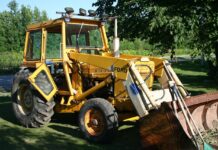Editor:
The National Animal Identification System (NAIS) has been alleged as a three component program, however a fourth component facade is starting to reveal itself.
The first step of NAIS is premises enrollment; next, animal identification; then coast-to-coast, 48 hour animal tracing.
USDA’s undersecretary for marketing and regulatory programs, Bruce I. Knight, has promised the NAIS program is easy to enroll and voluntary on the federal level, “if … enough livestock owners enroll so it does not have to go mandatory.”
The fourth component is meticulously touched by Knight, “If USDA decides to make all or parts of the NAIS mandatory, APHIS will follow the normal rulemaking process.”
With rules, laws, inspections, taxes, regulations, or licensing comes the fourth component: enforcement.
In 2007, the U.S. spent nearly $1 trillion in regulation enforcements, policing, investigations, and mandatory compliances. Although this was a huge expense to the citizenry, the fines, collections, penalties, licenses, fees and private property confiscations from all law violations was an equally swelling amount; a number impossible to locate from federal published data.
Penalties appropriate to the violation is a cornerstone fundamental of the U.S. judicial system. Enforcement is totally capricious with USDA. One could be fined in county court $1,000 for a 70 mph speed violation through a school zone, yet $50,000 for crossing a state line with one number incorrect on a USDA issued livestock health certificate — for a perfectly healthy child’s pony.
Government animal numbering systems have been urged in a few countries prior to the marketing of NAIS in the U.S. Australia is the only country to have implemented electronic tagging and tracking, and is a prototype for enforcement, also.
Stephen Blair, a director of the Angus Society of Australia, was recently fined $17,300. He was prosecuted for moving cattle from one of his ranches wearing ear tags from his other ranch to a livestock auction. No diseased or stolen livestock were involved.
This is a small example of the enforcement USDA could wield over U.S. livestock producers if NAIS was exacted mandatory. All licensed USDA veterinarians will be required to report all noncompliance of their clients or be subject to immediate licensing reviews.
The USDA/APHIS policing division is the Investigative and Enforcement Services, and to enforce the ever increasing number of regulations, the government seeks to make ordinary citizens into their enforcers. Even today all neighbors, farm employees and friend or foe associates are encouraged on the IES Web site to “report potential violations, please contact IES.”
The Fourth Component is operational and extremely aggressive. It can be disastrously expensive. NAIS, when mandatory, will require 100 percent computer movement documentation at the expense of livestock owners. In a three-year period, the total NAIS computer movement numbers in the USA will more than eclipse the number of all people living on Earth.
The whopping magnitude of this federal numbering burden will require a giant increase in USDA employees and facilities.
Every livestock producer is encouraged to study the details of NAIS and oppose NAIS now, rather than when it becomes scurrilously mandatory.
Darol Dickinson
Barnesville, Ohio













Thank you so much for printing this important piece about a conspicuously unmentionable aspect of the NAIS program. It is very refreshing to see the true realities in print!
Many people believe that since the first phase is currently free, the entire program will be – and that is simply not the case. The costs to producers go up with each phase, and rocket out of all proportion when one considers the enforcement issue.
Though on hold, the TX law was supposed to include a $1000 per day per animal penalty.
Since animals raised and moved in groups only count for one violation (since there is only a single ID), but a small flock of backyard chickens are counted individually, it should be obvious what this program is intended to do.
As we all know, any additional cost in production must ultimately be borne by the consumer – both in increased costs at retail, as well as in taxes (think of the sales tax implications alone!).
When one considers the 29 species involved, the loss of producers due to the cost of implementation, and the destruction of businesses due to enforcement issues, this program is a problem for everyone.
Increased costs on everything from leather to angora sweaters, glue to fertilizer, as well as food products from the obvious meat items to organic produce are sure to come.
I also wonder if they have solved all the problems the Wisconsin pilot programs (2005, 6 & 7) discovered with unreliable readers and ineffective as well as unresponsive software? All those mistakes will lead to a lot enforcement actions….
Sue
Thank you so much for this article. The USDA and their NAIS needs to be totally scrapped and our tax dollars (already spent on this idiotic idea) refunded to the American people. It will not work. Period. The American people are tired of the monetary burdens being generated by big business and shady politicians that turn their backs to the real needs in this country. Our freedom, privacy and small farms and ranches are being targeted and are in jeopardy. The public needs to become educated regarding our plight against a National Animal ID System in America. Thank you again for publishing one more voice of reason in our vast world of a very greedy and socialistic-minded bureaucracy.
Thanks for printing a peice that speaks critically about the USDA National Animal Identification System (NAIS). There seems to be a news blackout in media about NAIS except printing USDA press releases. NAIS probably represents the biggest threat to family farms. It will bury farms in useless paperwork and extra labor that will never benefit the farmer. And there are already USDA and state Ag programs that are trying to freeze “noncompliant” farms out of the marketplace. This issue needs be aired in public so more Americans understand the benefits of the program, the money to be spent on it and the unspecified costs to farms.
I hope that Farm and Dairy will followup this editorial with a full fledged well researched series of articles discussing the cost benefit ratio of NAIS.
It is great to see your publication take an in depth look at what NAIS is and what a mess it is going to create if it comes to be. It will end the small livestock farmers as we know them and centralize our food production/resources even more than it is today. For some reason it seems that every form of government wants to control more and more. Government entities are SUPPOSED TO BE our servants, but things are turning around so the population is governments servant. See what EPA is got up it’s sleeve for us at:http://online.wsj.com/article/SB121642309337666613.html?mod=opinion_main_review_and_outlooks
Again, thanks for printing this NAIS information.
John Dach